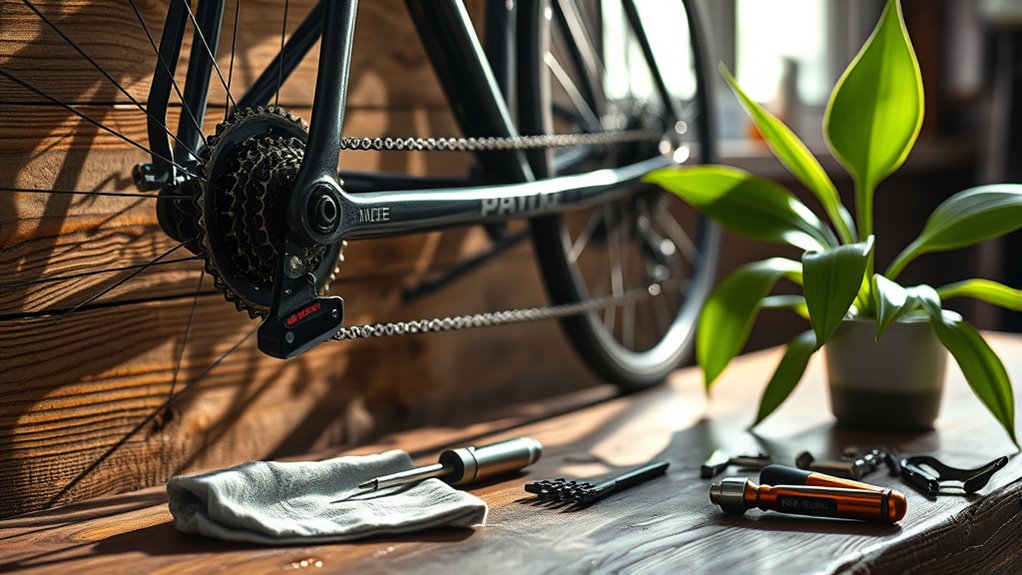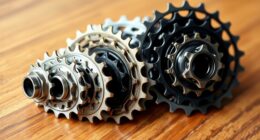To keep your ride smooth all year, start with pre-ride checks—check tire pressure, brakes, and chain condition. Clean your bike every 3-4 weeks and lubricate moving parts as needed. Regular maintenance, like assessing brake pads and inspecting for corrosion, is crucial for performance. Don’t forget to store your bike properly and check for wear before each ride. There’s more to explore about tire care and drivetrain management that’ll help you ride effortlessly.
Key Takeaways
- Regularly check tire pressure and inspect for wear or damage to ensure a safe ride.
- Clean and lubricate the chain and drivetrain every month to enhance performance and longevity.
- Inspect brakes and gears before every ride to guarantee smooth operation and safety.
- Maintain spoke tension and ensure wheels are true to prevent handling issues during rides.
- Store your bike properly, checking for rust and cleaning it to avoid corrosion and wear.
Pre-Ride Checks

Before hitting the road, you should perform a series of essential pre-ride checks to ensure your bike is safe and ready for your journey.
Start with tire checks: confirm the pressure is optimal and inspect for any wear, bulges, or embedded objects.
Start with tire checks: ensure optimal pressure and look for any signs of wear, bulges, or foreign objects.
Next, check your brakes—make sure they function independently, inspect the pads for wear, and verify that cables are secure.
Don’t forget your wheels; check spoke tension, ensure they’re true, and confirm quick releases are tight.
Review your drivetrain, lubricate the chain, and check for any wear.
Finally, inspect the frame and controls for damage and ensure everything is securely mounted.
These simple steps can prevent issues and enhance your ride experience.
Regular Cleaning
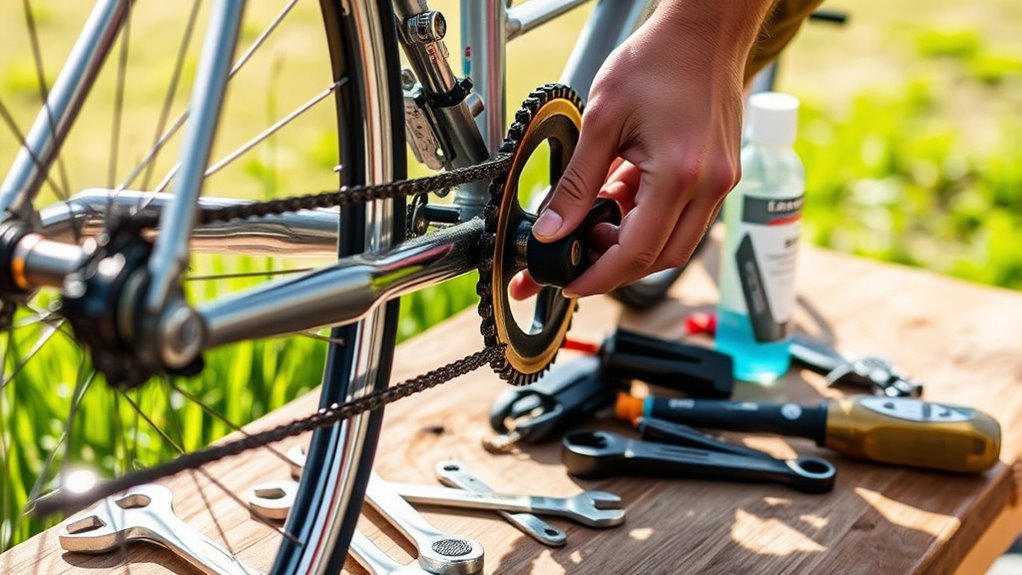
After ensuring your bike is safe with pre-ride checks, keeping it clean is vital for maintaining its performance and longevity.
Clean your bike every 3-4 weeks, or after rides in wet conditions, to prevent corrosion and wear.
Start with a bucket or garden hose and use environmentally friendly degreasers like Pedro’s Oranj Peelz for the chain.
Employ stiff-bristled brushes for the drivetrain and softer brushes for the frame and wheels.
Don’t forget to wipe down brake surfaces to avoid contamination.
Dry your bike thoroughly with a chamois leather, and consider applying a silicone spray for added protection. Regular cleaning not only enhances safety but also makes your bike visually appealing and enjoyable to ride.
Lubrication and Maintenance

Proper lubrication is crucial for your bike’s performance and longevity.
Start with the chain; lubricate it when it runs loudly or feels dry. Use wet lubricants for wet conditions and dry ones for dry weather. Apply lubricant by dripping it onto the chain while pedaling to spread it evenly, then wipe off any excess to prevent dirt buildup.
Lubricate your chain when it sounds loud or feels dry, using the right lubricant for the weather.
Don’t forget to lubricate derailleurs, brake levers, cables, and jockey wheels to ensure smooth operation. Check and clean the chain weekly and perform a thorough bike cleaning monthly.
Avoid over-lubricating and never use WD-40 as it’s not suitable. Regularly inspect cables for wear to keep everything running smoothly and efficiently.
Safety and Performance Checks
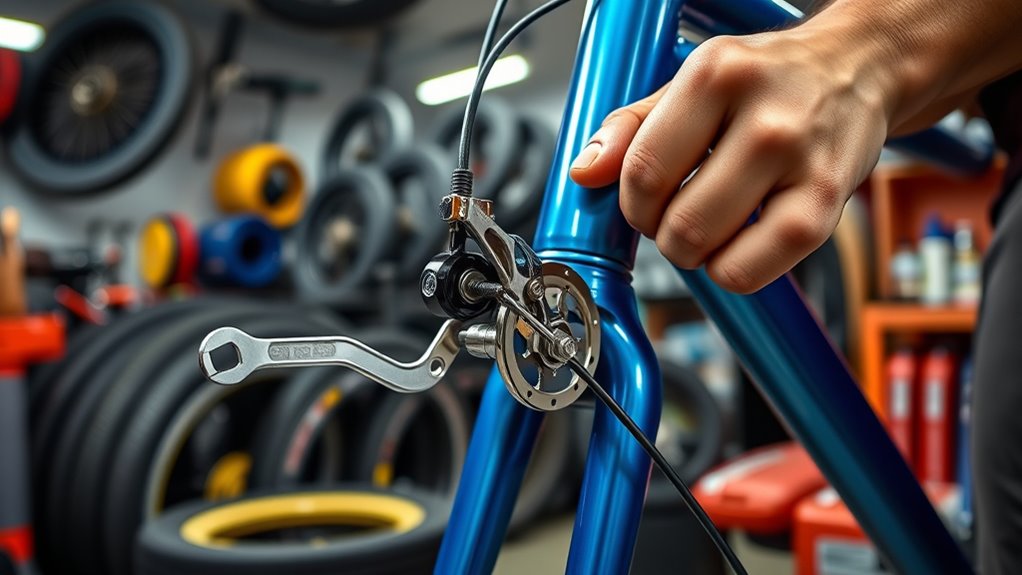
Maintaining your bike’s performance doesn’t just stop at lubrication; regular safety and performance checks are vital to ensure a smooth ride.
Start with a tire inspection—check for proper inflation and remove debris. Next, ensure your brakes engage smoothly and effectively, and verify your chain is clean and well-lubricated.
Don’t forget to check that your wheels are securely attached and that all essential bolts are tight.
Before every ride, evaluate gear shifting for smooth operation and test your brake performance. Maintain optimal tire pressure for better handling, and check your wheels for trueness.
Advanced Maintenance Tasks
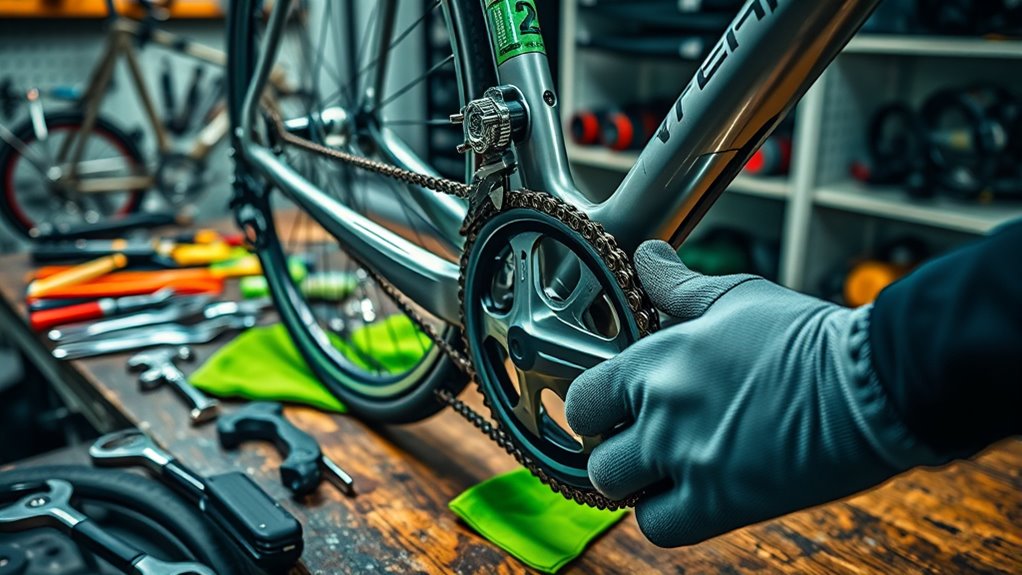
While routine maintenance keeps your bike running smoothly, advanced maintenance tasks take your bike care to the next level.
Start with your brake system: regularly inspect brake pads for wear and check rotors for warping. Don’t forget to monitor fluid levels and bleed the system when needed.
Next, focus on your chain and gears. Measure chain wear, adjust derailleurs, and keep your cassette and chainrings clean.
Maintain your chain and gears by measuring wear, adjusting derailleurs, and ensuring your cassette and chainrings stay clean for optimal performance.
For suspension, adjust sag based on your weight and inspect the frame for cracks.
Finally, ensure your wheels are true, check tire pressure, and verify spoke tension.
Each of these tasks enhances performance and extends your bike’s lifespan, keeping your ride safe and enjoyable.
Seasonal and Environmental Considerations

As you ride through the changing seasons, adapting your bike maintenance routine to environmental factors is crucial for optimal performance.
In winter, deep clean and lubricate your bike to guard against moisture and corrosion.
In summer, combat heat and dust with regular cleaning and lubrication to keep everything running smoothly.
Spring’s the perfect time for off-season maintenance—check for worn components and replace them as needed.
As autumn approaches, store your bike in a cool, dry place to prevent rust.
Throughout the year, inspect brakes, suspension, and drivetrain regularly.
Protect your bike from moisture and extreme temperatures by using frame protection tape and ensuring a proper setup for varying weather conditions.
Stay proactive to enhance safety and performance!
Tire Maintenance

Proper tire maintenance is essential for a smooth and safe ride, as it directly impacts your bike’s performance and longevity.
Start by checking your tire pressure before every ride—road bikes need 80-130 psi, while mountain bikes require 25-35 psi. Use a reliable pressure gauge for accurate readings.
Check tire pressure before each ride: 80-130 psi for road bikes, 25-35 psi for mountain bikes.
Inspect your tires for cuts, punctures, or debris, and wipe them down after each ride to keep them clean and performing well. Look for signs of wear, like smooth tread or sidewall damage, which indicate it’s time for a replacement.
Lastly, ensure you have essential tools such as tire levers, patch kits, and a portable pump for quick fixes. This proactive approach keeps your ride safe and enjoyable.
Brake System Care

Your bike’s brake system is crucial for safety and performance, so regular care is a must.
Start by checking your brake pads for wear; replace them if they’re worn down. Clean them with sandpaper if they become glazed to enhance braking power.
For disc brakes, ensure your rotors are grime-free by wiping them with a cloth and degreaser—never use oil, as it hampers performance.
Inspect your brake cables for fraying or rust, lubricate them for smooth operation, and adjust levers for proper alignment.
Regularly check brake fluid levels on hydraulic systems and consider bleeding them to remove air.
Performing these checks ensures your brakes work efficiently, keeping your rides safe and enjoyable.
Drivetrain Management
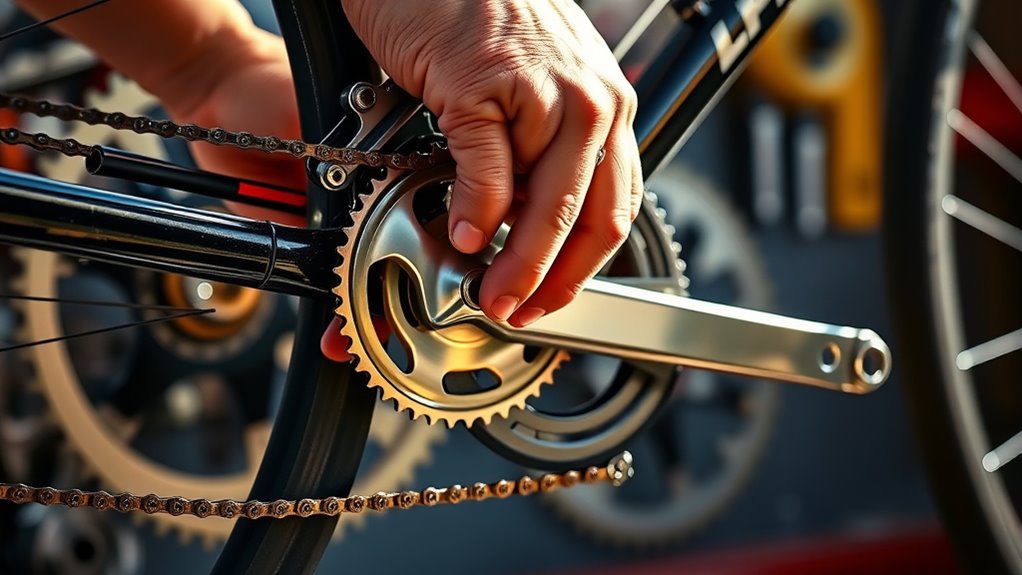
Maintaining your bike’s brake system sets the stage for effective drivetrain management, which directly impacts your riding experience.
Start by regularly cleaning your chain, cassette, and derailleur using a degreaser to eliminate dirt and grime. Use chain cleaning tools and soft-bristled brushes for delicate areas, rinsing thoroughly afterward.
Once dry, lubricate your chain, ensuring you apply the right type based on your riding conditions—wet or dry lube. Avoid over-lubricating, as it attracts dirt.
Check your drivetrain every 100-200 miles and inspect the chain for wear monthly. Address derailleur issues promptly to maintain smooth shifting.
Storage Tips for Longevity

While storing your bike might seem like a simple task, choosing the right location and protective measures can significantly extend its lifespan.
Store your bike in a dry, cool, and dark place like a garage or shed to protect it from moisture and sunlight. Avoid direct sunlight, which can fade paint and degrade components. Use bike covers or protective bags to keep dust and moisture at bay.
Make sure your storage area is secure and well-lit to deter theft. Regularly inspect your bike and storage solutions for any signs of wear.
Finally, clean your bike before storage, lubricate the moving parts, and inflate the tires to prevent flat spots. With these tips, your bike will be ready for your next ride!
Frequently Asked Questions
How Often Should I Replace My Bike Tires?
You should replace your bike tires based on mileage and condition.
Generally, road tires need replacement after about 2000 miles, while racing tires may wear out after 1500 miles.
If you ride frequently, inspect for signs of wear like cracking or reduced grip.
It’s also wise to consider the age of the tires; most brands suggest replacing them every 3 to 5 years, regardless of usage.
Regular checks will help ensure your safety on the road.
What Tools Do I Need for Basic Bike Maintenance?
For basic bike maintenance, you’ll need a few essential tools.
Grab an Allen wrench set for adjustments, tire levers for fixing flats, and chain lube to keep your chain smooth.
A floor pump with a gauge ensures your tires are properly inflated, while spare tubes are critical for quick repairs.
Having a multi-tool handy can also cover various functions, making your maintenance tasks easier and more efficient.
Can I Wash My Bike With a Pressure Washer?
You might wonder if you can wash your bike with a pressure washer, but consider the risks and benefits.
While it can save you time, it can also force water into sensitive areas, leading to corrosion. If you do use one, keep your distance and avoid sensitive components.
Alternatively, using a garden hose or manual cleaning can be safer and just as effective.
Prioritize your bike’s longevity by choosing the right cleaning method.
How Do I Know if My Bike Frame Is Damaged?
To know if your bike frame is damaged, start with a visual inspection. Look for cracks, bends, or deep gouges, especially around critical areas like the head tube and bottom bracket.
Use your hands to feel for irregularities and listen for any unusual sounds while riding. After any accident, check for hidden damage.
If you suspect issues, don’t hesitate to get a professional assessment to ensure your safety on the road.
Should I Adjust My Bike’s Seat Height Frequently?
Yes, you should adjust your bike’s seat height frequently. Regular adjustments enhance your comfort and pedaling efficiency, helping you avoid fatigue.
If you notice discomfort or changes in your riding style, it’s time to make a tweak. Keep an eye on your riding conditions, too, since they can impact your ideal seat height.
Conclusion
By keeping up with your bike maintenance, you’re not just preserving a machine; you’re ensuring every ride feels like gliding through a sunlit meadow. Picture smooth gears shifting effortlessly, tires gripping the road like a trusty friend, and brakes responding with a reassuring squeeze. With these simple steps, your bike will be ready to tackle any adventure, rain or shine. So gear up, hit the road, and let the journey unfold with every pedal stroke!
